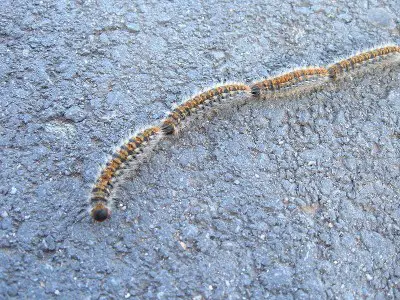The etymological origins of the word are from the early 16th century, from Middle English catirpel, catirpeller, probably an alteration of Old North French catepelose: cate, cat (from Latin cattus) + pelose, hairy (from Latin pilōsus).[
Most caterpillars have tubular, segmented bodies. They have three pairs of true legs on the three thoracic segments, up to four pairs of prolegs on the middle segments of the abdomen, and often a single pair of prolegs on the last abdominal segment. There are ten abdominal segments. The families of lepidoptera differ in the numbers and positioning of the prolegs. Some caterpillars are fuzzy (which means they have hair), and they are most likely to cause itching of the hands if touched.
Caterpillars grow through a series of moults; each intermediate stage is called an instar. The last moult takes them into the inactive pupal or chrysalis stage.
Like all insects, caterpillars breathe through a series of small openings along the sides of their thorax and abdomen called spiracles. These branch into the body cavity into a network of tracheae. A few caterpillars of the family Pyralidae are aquatic and have gills that let them breathe underwater.
Caterpillars have about 4,000 muscles (compared to humans, with 629). The average caterpillar has 248 muscles in the head segment alone.
Caterpillars move by sliding their internal organs forward using contraction of the muscles; the torso first elongates and then contracts like a slinky. They are one of the only known organisms that use this method of locomotion. Another way of describing this process is: gut-first, body-later.
 Caterpillars do not have good vision. They have a series of six tiny eyelets or 'stemmata' on each side of the lower portion of their head. These can probably form well focused, but poorly resolved images. They move their heads from side to side probably as a means of judging distance of objects, particularly plants. They rely on their short antennae to help them locate food.
Caterpillars do not have good vision. They have a series of six tiny eyelets or 'stemmata' on each side of the lower portion of their head. These can probably form well focused, but poorly resolved images. They move their heads from side to side probably as a means of judging distance of objects, particularly plants. They rely on their short antennae to help them locate food.
Some caterpillars are able to detect vibrations, usually at a specific frequency. Caterpillars of the common hook-tip moth, Drepana arcuata (Drepanoidea) produce sounds to defend their silk nests from members of their own species, by scraping against the leaf in a ritualized acoustic duel. They detect the vibrations conducted by the plant and not airborne sounds. Similarly, cherry leaf rollers Caloptilia serotinella defend their rolls. Tent caterpillars can also detect vibrations at the frequency of wing beats of one of their natural enemies
Classification
The geometrids, also known as inchworms or loopers, are so named because of the way they move, appearing to measure the earth (the word geometrid means earth-measurer in Greek); the primary reason for this unusual locomotion is the elimination of nearly all the prolegs except the clasper on the terminal segment.
Caterpillars have soft bodies that can grow rapidly between moults. Only the head capsule is hardened. In caterpillars, the mandibles are tough and sharp for chewing leaves; in most adult Lepidoptera, the mandibles are highly reduced, or soft. Behind the mandibles of the caterpillar are the spinnerets, for manipulating silk.
Some larvae of the Hymenoptera (ants, bees and wasps) order can appear like the caterpillars of the lepidoptera. These are mainly seen in the Sawfly family and while the larvae superficially resemble caterpillars, they can be distinguished by the presence of prolegs on every abdominal segment. Another difference is that lepidopteran caterpillars have crochets or hooks on the prolegs while these are absent on the sawfly larvae. Also in lepidopteran caterpillars is the upside down Y shaped suture on the front of the head. The larvae of sawflies differ also in having prominent ocelli on the head capsule.
 most dangerous caterpillar
most dangerous caterpillar
 most dangerous caterpillar
most dangerous caterpillar
 most dangerous caterpillar
most dangerous caterpillar
 most dangerous caterpillar beautifull
most dangerous caterpillar beautifull
 most dangerous caterpillar
most dangerous caterpillar
 most dangerous caterpillar
most dangerous caterpillar
 most dangerous caterpillar
most dangerous caterpillar
 most dangerous caterpillar
most dangerous caterpillar
No comments:
Post a Comment